Blasting into inner space
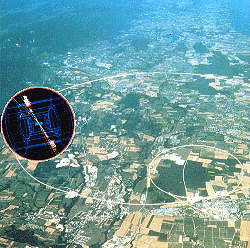
Smash site
The path of the underground accelerator and smaller booster ring at CERN,
where violent collisions occur |
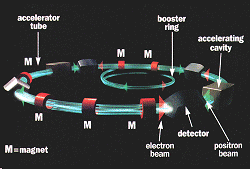 |
A collision machine
It takes machines the size of a small city to create the huge
energies needed to study subatomic particles. The ring of LEP, which has
been operating at CERN since 1989, sits in a tunnel 100 metres deep. Along
it are thousands of magnets which bend and focus opposing beams of electrons
and positrons. The beams - siphoned in from a series of smaller accelerators
- are given a final boost by a radio-frequency electric field. At four places
the beams are brought together into a fine point by superconducting magnets.
The debris from the resulting collisions is analysed on a computer. |
For the first time,new super-machines are opening up the incredible worlds
deep inside matter
How do scientists go about testing theories and discovering new particles?
In the early years of particle physics scientists relied on natural processes
that create subatomic particles - for example, radioactivity in which nuclei
with unstable arrangements of protons and neutrons break down to release
electrons, helium nuclei (alpha particles) and gamma radiation. Cosmic rays
provided the other source of particles.
What scientists wanted were machines that could smash up the nuclei of ordinary
matter to reveal what's inside. But it requires high energies to overcome
the powerful nuclear "strong force" The obvious way to do this is by bombarding
the target nucleus with fast-moving electrons and protons in the hope of
knocking it open.
It's a bit like crashing a car into a wall and hoping to find out how the
engine works. But physicists have made some remarkably accurate inferences
by detecting particles that are kicked out by the collision and measuring
which way they go.
UNITS OF ATOMIC
ENERGIES
-
Electron Volt (eV) - the energy one electron acquires
when accelerating through one volt of potential difference
MeV - mega (106) eV
GeV - giga (109) eV
TeV - tera (1012) eV
-
Particle masses can be expressed as energy according
to E=mc2, because m=E/c2
(m = mass; E= energy)
|
Charged particles are accelerated by passing them through an electric field.
The first machines, in the 1930s, generated 700,000 volts to accelerate protons
(hydrogen atoms without their electrons). When they hit the target material
they caused some of the nuclei to break up.
A real breakthrough came with the cyclotron, invented by Ernest Lawrence
in 1931.
Charged particles introduced into the machine were sent whirling round in
a circle by the magnetic fields applied from above and below. An alternating
electric field between a pair of D-shaped electrodes caused the particles
to accelerate every time they crossed the gap. This first cyclotron reached
the then-astonishing energy of 80,000 electron volts (80 keV) (see units
box).
Today, the most powerful accelerators are synchrotrons, which consist of
a circular vacuum-filled tube. Electromagnets situated along the ring at
regular intervals bend the paths of the particles as they whizz down the
tube, and keep them going in a constant circular orbit.
Electrons amd positrons annihilate each other in bursts of pure energy
As well as bending magnets (which are dipole), there are special magnets
with four or six poles which focus the particles into a pencil-like beam.
Also along the ring are devices that produce a radio frequency field, which
accelerates the particles close to the speed of light.
Giant detectors in the accelerator
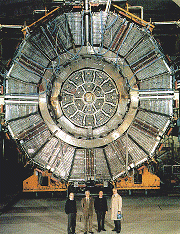
To detect collisions in the giant LEP accelerator there are
four giant instruments - Aleph, Delphi, L3 and Opal - placed at intervals
along the ring. These record every nuance of every particle "event" that
happens in their vicinity.
Each detector has a slightly different configuration and measures slightly
different things. This way they can verify each other's results.
Aleph is typical: it is an onion-shaped structure through which the accelerator
tube passes. Six layers measure the type, direction and energy of the particles
produced in the collision. The inner three layers are composed of solid-
state and MWPC detectors (see box, far right), which measure the tracks of
charged particles.
A superconducting magnet surrounding the layers bends the particle tracks
according to their mass and electric charge. This allows their momentum to
be deduced.
Direct hit!
A computer reconstruction (right) of particles emerging from a collision
of an electron and a positron at the centre of the Aleph detector
(above) |
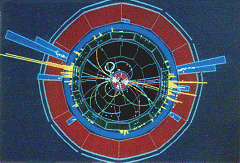 |
Two outside layers stop particles to measure their energies;
only neutrinos and muons escape. Muons are detected in wire chambers in the
outer shell. But neutrinos are traced by the momentum left when the momentum
of all the other particles has been added up.
All the data is collected via electronic channels, then processed and
analysed. |
The reason synchrotrons are used is because they keep particles circulating
and accelerating. There is one disadvantage: particles travelling in a magnetic
field at near-light speeds lose energy by emitting it as radiation. The more
sharply they bend, the faster they go, and the more energy they lose. So
the more energy you want to achieve, the larger the accelerator ring must
be.
The largest accelerator, called LEP (Large Electron Positron Collider), is
at CERN in Geneva and is a whopping 27 kilometres in circumference. As one
of a new generation of super-machines, it uses a lot of energy - a tenth
of the electricity that Geneva uses. These accelerators collide beams of
particles circling in opposite directions, so that they meet at twice the
energy of each beam.
LEP smashes electrons and their antimatter counterparts, positrons, at energies
of 100 GeV, which annihilate each other in a burst of pure energy. This
crystallises into the Z, one of the recently discovered particles that carries
the weak force. The Z decays rapidly into a shower of other particles. The
particles, which are in bunches, then meet at four crossing points along
the ring, where there are detectors to record the collisions.
LEP's job is to test the Standard Model to a very high precision. So far
results have proved that there are only three generations of particles (some
scientists thought there could be more), and confirmed many other predictions.
How to see 'invisible' particles
|
You might wonder how you I can see something as
small as a subatomic particle. Fortunately almost all particles interact
with something to give a tiny signal, which can be amplified into something
visible. For instance, a charged particle produces a tiny flash of light
in some crystals. A device called a photomultiplier can convert the flash
into an electrical signal, which can then be visualised electronically.
Cloud chambers were the first detectors. They worked by producing a tiny
vapour trail, similar to that caused when water vapour condenses on the exhaust
of an aeroplane.
Later, photographic emulsions were used to take a snap- shot of charged
particles, which leave dark tracks on the plate. Emulsions were very useful
for detecting cosmic rays and are still used for small experiments. |
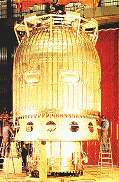 |
| The bubble chamber that CERN used in the 1970s and 1980s
|
|
Bubble chamber
These are the most famous kind of detectors. Inside the bubble chambers,
particles produce beautiful swirling shapes.
Liquid hydrogen in the chamber is allowed to expand suddenly when a particle
passes through it, and a trail of bubbles is left in the particle's wake.
Until recently the bubble chamber was the mainstay of particle physics
experiments. But it is not suitable for accelerators that used colliding
beams, as in these particle collisions occur in the accelerator, rather than
an external chamber. |
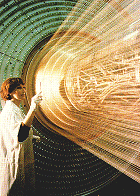 |
| In a drift chamber fine wires detect the tracks of charged
electrons |
|
The multiwire chamber
Colliders like LEP use a whole range of new detectors such as the drift chamber
and the Multi- wire Proportional Chamber (MWPC). This clever device won George
Charpak, who works at CERN, the Nobel physics prize last year. The MWPC consists
of a gas-filled box with a plane of "sense" wires stretched inside it. When
a particle passes through the gas it knocks electrons out of the gas molecules,
which drift towards the positively charged wires. Each electron knocks out
further electrons, producing an avalanche of electrons around the wires.
This multiplies the electrical signal 100.000 times. |
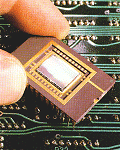 |
| The CCD chip used to detect particles is also found in
camcorders |
|
Solid-state detectors
The silicon chip has found its way into particle detectors. One of the most
important devices is the charge-coupled device, or CCD. This is a chip covered
in tiny pixels, squares that can store the charge produced when charged particles
strike them.
The resulting two-dimensional electronic "image" is then converted into a
series of pulses of varying voltages, which in turn become a computer image.
|
|
 Mar94 p56
Mar94 p56






